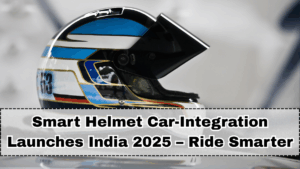India’s mobility ecosystem is entering a futuristic phase as Upcoming Smart Helmet Car Integration Launches India 2025 introduce a completely new approach to rider safety, connectivity, and vehicle interaction. The idea of linking helmets to vehicles is quickly becoming reality, thanks to advancements in Bluetooth communication, IoT sensors, AI-driven alerts, and V2X (Vehicle-to-Everything) technologies. In 2025, several brands will launch smart helmets that can communicate with cars, two-wheelers, and roadside infrastructure to improve safety and enhance riding experiences.
Smart helmets are designed to reduce accidents caused by blind spots, distracted riding, and unpredictable urban traffic. With India accounting for a high number of two-wheeler accidents each year, the integration of helmets with vehicle systems could be a game-changer. Through features like collision alerts, turn-by-turn navigation, driver behaviour analysis, and automated emergency responses, smart helmets will play a major role in the future of two-wheeler integration India.

Major Smart Helmet + Car Integration Launches in 2025
1. Hero SmartRide Helmet 2025 – Connected Safety for Commuters
Hero MotoCorp is expected to introduce an upgraded SmartRide helmet that pairs with both two-wheelers and cars for better situational awareness.
Key Highlights:
• Alerts for nearby cars
• Built-in speakers + mic
• Real-time navigation prompts
USP: Best option for daily commuters
2. TVS IntelliHelmet – Complete Vehicle Ecosystem Connectivity
TVS’s upcoming IntelliHelmet will integrate directly with scooters and EVs, offering advanced telematics and ride analytics.
Key Highlights:
• Turn-by-turn audio guidance
• Blind-spot alerts
• Link with TVS scooters + supported cars
USP: Designed for urban EV riders
3. Royal Enfield RideSync Helmet – Touring + Safety Combined
Royal Enfield is working on a touring-focused helmet that connects with GPS, car navigation systems, and ride groups.
Key Highlights:
• Group ride sync
• Emergency SOS
• Long-ride battery backup
USP: Ideal for highway and adventure riders
4. IGNYTE Smart Vision Helmets – Premium AR Display
IGNYTE is preparing a premium AR helmet featuring a heads-up display (HUD) that integrates with car tech to project warnings.
Key Highlights:
• AR visual navigation
• Car-proximity warnings
• Built-in dash camera
USP: Futuristic AR experience for tech enthusiasts
5. Shellios XTRA Helm – Health + Safety in One Device
Shellios will offer a smart helmet that integrates with both two-wheelers and compatible cars for air quality monitoring and traffic alerts.
Key Highlights:
• Pollution filtration
• AI-based fatigue monitoring
• Quick-pair system
USP: Best for health-conscious city riders
Why Smart Helmet + Vehicle Integration Matters
Smart helmets represent the next step in India’s push for safer two-wheeler mobility. These integrations create an ecosystem where helmets, cars, bikes, and traffic systems work together to reduce accidents and improve rider awareness.
Benefits include:
• Real-time hazard detection
• Alerts during lane shifting by nearby cars
• Better navigation without screen distraction
• Automatic crash detection and emergency response
• Safer night and fog riding
The smart helmet car tech India 2025 revolution aligns with India’s broader mobility transformation, focusing on reducing road accidents and improving vehicle-to-rider communication.
Technology Behind 2025 Smart Helmets
Modern smart helmets combine several advanced technologies to create a safer riding environment.
Key tech features:
• Bluetooth 5.3 for faster pairing
• MEMS sensors for collision detection
• AI for analysing rider behaviour
• HUD displays for navigation
• Cameras for blind-spot monitoring
• V2X communication for interacting with cars
All these systems work seamlessly to provide real-time updates and make riding more intuitive.
Battery, Build & Comfort Enhancements
Smart helmets launching in 2025 will also focus on ergonomics and practicality. Companies are improving battery life, ventilation, and build quality while keeping weight low.
Upgrades to expect:
• Lightweight composite shells
• 10–15 hours battery backup
• Quick charging via Type-C
• Adjustable padding
• Better wind noise reduction
These improvements ensure that safety, comfort, and tech convenience go hand-in-hand.
Why 2025 Is a Key Turning Point
Government agencies, automakers, and tech startups are collaborating to build a connected mobility platform where helmet safety integrates with cars and road systems. With rising traffic density and growing two-wheeler sales, India needs smarter riding solutions, making 2025 the perfect year for mass adoption.
FAQs
Do smart helmets work with all cars?
Only select helmets support vehicle integration, depending on software compatibility.
How long does the battery last?
Most 2025 smart helmets offer 10–15 hours of continuous use.
Are these helmets legal in India?
Yes, certified ISI/ISI+DOT/ECE models with smart features are legal.
Can smart helmets reduce accidents?
Yes, real-time alerts and collision warnings significantly improve rider awareness.
Will smart helmets be expensive?
Premium models will cost more, but affordable mid-range options will launch by late 2025.
Click here to know more.
